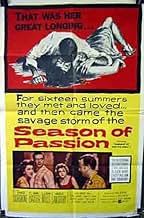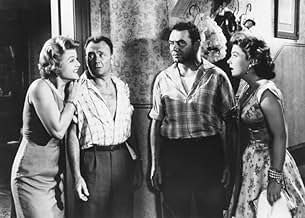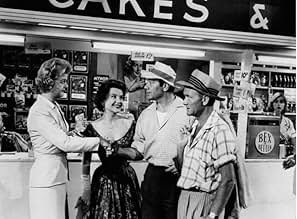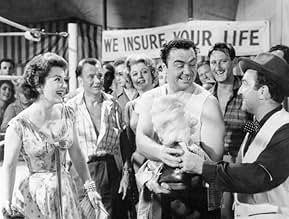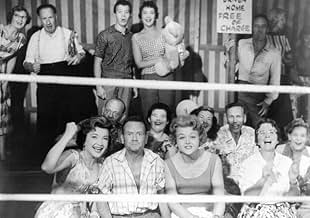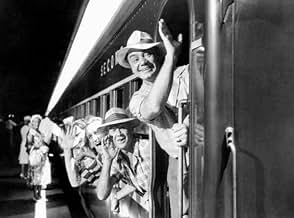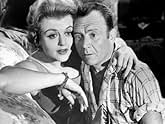AVALIAÇÃO DA IMDb
5,9/10
336
SUA AVALIAÇÃO
Adicionar um enredo no seu idiomaTwo Australian sugarcane cutters spend their annual five-month vacations in Sydney with their mistresses.Two Australian sugarcane cutters spend their annual five-month vacations in Sydney with their mistresses.Two Australian sugarcane cutters spend their annual five-month vacations in Sydney with their mistresses.
- Direção
- Roteiristas
- Elenco e equipe completos
- Produção, bilheteria e muito mais no IMDbPro
Avaliações em destaque
It's odd that in this Australian film set in that beautiful country that none of the stars are, in fact, Australian! You've got two Americans (Ernest Borgnine and Anne Baxter) and two Brits (John Mills and Angela Lansbury) starring in this one! Sadly, the Aussie actors just weren't all that famous at the time and in a bid to get international box office money, they cast foreigners in this very Australian tale! If made today, at least they could have used Paul Hogan or Dame Edna, as they both are known internationally! Sadly, Borgnine sounded about as Australian as Charles Boyer, though the others at least sound reasonably good to this untrained ear.
As far as the story goes, it's about a couple guys who work the cane fields and then come back to the big city to have a good time with their mistresses. Not especially bad or good...and a film that never really impressed me one way or the other. This, combined with the casting, make this one I could easily have skipped.
As far as the story goes, it's about a couple guys who work the cane fields and then come back to the big city to have a good time with their mistresses. Not especially bad or good...and a film that never really impressed me one way or the other. This, combined with the casting, make this one I could easily have skipped.
I read with some interest the comments by Aussie reviewers on this film before writing my own review. They seem to think the spirit of Ray Lawler's play was cut right of the film version of The Summer Of The 17th Doll. My own view just as it was the producer's choice to hire American and British leads it was also his choice to bow to American censor requirements and omnipresent Code still in force.
I sympathize with the the Aussies who complain that one of their own should have been in the lead. Certainly Chips Rafferty who was the biggest name in Aussie cinema at the time could have taken Ernest Borgnine's part. He sure had the size for it.
Summer Of The 17th Doll casts Borgnine and John Mills as a pair of sugar cane cutters who are now at liberty as the occupation is seasonal. Borgnine's size and strength make him respected while Mills reputation and identity come from his love 'em and leave 'em attitude with women. Both have their steady girls Anne Baxter and Angela Lansbury as anchors of a sort.
But these two women are getting tired of being a pair of Adelaides for their Nathan Detroits. Plain and simple these two won't acknowledge they're not young any more. Plain and simple they won't grow up.
And that's a universal situation not necessarily an Australian one. If Summer Of The 17th Doll were remade today I can see Nicole Kidman as one of the women and Guy Pearce as one of the men. And the Code restrictions would be off.
Still while it's not all it could be, Summer Of the 17th Doll is a fine bit of film making.
I sympathize with the the Aussies who complain that one of their own should have been in the lead. Certainly Chips Rafferty who was the biggest name in Aussie cinema at the time could have taken Ernest Borgnine's part. He sure had the size for it.
Summer Of The 17th Doll casts Borgnine and John Mills as a pair of sugar cane cutters who are now at liberty as the occupation is seasonal. Borgnine's size and strength make him respected while Mills reputation and identity come from his love 'em and leave 'em attitude with women. Both have their steady girls Anne Baxter and Angela Lansbury as anchors of a sort.
But these two women are getting tired of being a pair of Adelaides for their Nathan Detroits. Plain and simple these two won't acknowledge they're not young any more. Plain and simple they won't grow up.
And that's a universal situation not necessarily an Australian one. If Summer Of The 17th Doll were remade today I can see Nicole Kidman as one of the women and Guy Pearce as one of the men. And the Code restrictions would be off.
Still while it's not all it could be, Summer Of the 17th Doll is a fine bit of film making.
Ernest Borgnine and John Mills star in this butchering of the Ray Lawlor play about cane cutters in the off - season.
Borgnine, known at the time as the star in "McHale's Navy", is the middle aged labourer (actually about 33 years old or so in the play) past his prime and Mills is his mate.
Angela Lansbury plays herself as a widow replacing Mills' girlfriend. In the play she was more salty than high class.
In the play, "Barney" - played by Mills - was still a fairly young man (still in his mid-ish twenties).
There is an odd scene where Bubba, the young ingenue is a barmaid filling up schooners with dregs (a Scottish bar ?).
Product placements - Peters Icecream (twice), Brylcreem, Toohey Old (twice), TAA (airlines), Tooths (beer) and Bex (twice - aspirin).
Borgnine, known at the time as the star in "McHale's Navy", is the middle aged labourer (actually about 33 years old or so in the play) past his prime and Mills is his mate.
Angela Lansbury plays herself as a widow replacing Mills' girlfriend. In the play she was more salty than high class.
In the play, "Barney" - played by Mills - was still a fairly young man (still in his mid-ish twenties).
There is an odd scene where Bubba, the young ingenue is a barmaid filling up schooners with dregs (a Scottish bar ?).
Product placements - Peters Icecream (twice), Brylcreem, Toohey Old (twice), TAA (airlines), Tooths (beer) and Bex (twice - aspirin).
At first glance it seems odd that a play set in a single room in the Melbourne suburb of Carlton in 1953 would have inspired Hollywood to turn it into a movie.
At the heart of Ray Lawler's play is the story of people who have a unique relationship, but are aging and trying to recapture happier times. The play had a terrific sense of nostalgia, and the annual gift of the kewpie dolls were sad symbols of a time that was ending. Finally, the characters must come to terms with what they want from each other or what they can never receive. Although the setting is Australian the emotions are universal.
There were many changes for the film. Some may have actually tightened the drama: the conflict between old friends Roo and Barney starts much earlier and the character of Dowd is given more to do. However the Luna Park sequence is heavy-handed and the ending is softer.
Ernest Borgnine gave a passionate performance as Roo, but he struggled with the accent and he was never laid back enough. Australian Vincent Ball who played Dowd probably could have played the part, but he was hardly international box office.
A year later, in "The Sundowners", an American star did play the type of Australian represented by Roo - Robert Mitchum. He got the accent about right, and he caught the tone; what might "Doll" have been with him in the role?
Anne Baxter fared best. Although the accent slipped here and there, she created a warm and disarming Olive. The accent probably would have been pretty close four years later after she had lived that time on a property near Gloucester in NSW with her American husband. She was a brilliant woman on many levels who wrote of her experiences in "Intermission" - a fascinating outsider's view of life in rural Australia in the early 1960's.
Accents aside, John Mills seemed a little too hyper anyway, but Angela Lansbury otherwise hit the right note as Pearl.
The whole production has the feel of a British Ealing production, especially Benjamin Frankel's score, which is similar to his work for British films.
The location was changed to Sydney opening the action out from the play. The exterior of Olive's house was in Glen Street, Milsons Point - the whole street is now high-rise apartments and office blocks although the view over Luna Park can still be recognised.
I still find the film interesting, flaws and all. Both play and film are set in an Australia that is hardly recognisable now, but both capture feelings of loss and fear of change that are as relevant today as they were then.
At the heart of Ray Lawler's play is the story of people who have a unique relationship, but are aging and trying to recapture happier times. The play had a terrific sense of nostalgia, and the annual gift of the kewpie dolls were sad symbols of a time that was ending. Finally, the characters must come to terms with what they want from each other or what they can never receive. Although the setting is Australian the emotions are universal.
There were many changes for the film. Some may have actually tightened the drama: the conflict between old friends Roo and Barney starts much earlier and the character of Dowd is given more to do. However the Luna Park sequence is heavy-handed and the ending is softer.
Ernest Borgnine gave a passionate performance as Roo, but he struggled with the accent and he was never laid back enough. Australian Vincent Ball who played Dowd probably could have played the part, but he was hardly international box office.
A year later, in "The Sundowners", an American star did play the type of Australian represented by Roo - Robert Mitchum. He got the accent about right, and he caught the tone; what might "Doll" have been with him in the role?
Anne Baxter fared best. Although the accent slipped here and there, she created a warm and disarming Olive. The accent probably would have been pretty close four years later after she had lived that time on a property near Gloucester in NSW with her American husband. She was a brilliant woman on many levels who wrote of her experiences in "Intermission" - a fascinating outsider's view of life in rural Australia in the early 1960's.
Accents aside, John Mills seemed a little too hyper anyway, but Angela Lansbury otherwise hit the right note as Pearl.
The whole production has the feel of a British Ealing production, especially Benjamin Frankel's score, which is similar to his work for British films.
The location was changed to Sydney opening the action out from the play. The exterior of Olive's house was in Glen Street, Milsons Point - the whole street is now high-rise apartments and office blocks although the view over Luna Park can still be recognised.
I still find the film interesting, flaws and all. Both play and film are set in an Australia that is hardly recognisable now, but both capture feelings of loss and fear of change that are as relevant today as they were then.
Ray Lawler's play about two tempestuous sweetheart couples coping with the layoff season in Sydney, Australia comes to the screen without much humor and a misguided heart. Sugar cane cutters Ernest Borgnine and John Mills take Kewpie doll collector Anne Baxter and manicurist Angela Lansbury to South Australia to rest up and look for holiday work--but trouble brews with Borgnine, who has mysteriously left his job after fifteen years. Practically without plot, this character study has become, on film, a visual journey rather than an emotional or personable one. Paul Beeson's cinematography is certainly striking, even as the entangled relationships and mercurial tempers at the forefront of the story quickly wear themselves out. Forget about accents, these actors (interestingly, if unsuccessfully, cast) don't even look like Aussie natives. Borgnine's strong sense of character and natural way with a complicated chunk of dialogue nearly saves him, but it was a fundamental error to surround these stars with unknown players who really do sound like Australians. The lively section at the amusement park is full of raucous vitriol and Beeson's playful visual composition, but every scene back at the boarding house is a lost cause. A very strange project, indeed. ** from ****
Você sabia?
- CuriosidadesAccording to the book "Australian Film & TV Companion" by Tony Harrison, Burt Lancaster, Rita Hayworth, and James Cagney were originally to have starred. Lancaster's company produced the film, but he did not appear in it.
- Erros de gravaçãoAn obvious stunt double is thrown through the ropes at the wrestling match.
- ConexõesReferenced in Cane Cutter (2008)
- Trilhas sonorasGood King Wenceslas
Music traditional and lyrics by John M. Neale and Thomas Helmore
(uncredited)
Heard as background music
Principais escolhas
Faça login para avaliar e ver a lista de recomendações personalizadas
Detalhes
- Data de lançamento
- Países de origem
- Idioma
- Também conhecido como
- Season of Passion
- Locações de filme
- Luna Park, North Sydney, Nova Gales do Sul, Austrália(Location for big night-time crowd scene)
- Empresa de produção
- Consulte mais créditos da empresa na IMDbPro
- Tempo de duração1 hora 33 minutos
- Cor
Contribua para esta página
Sugerir uma alteração ou adicionar conteúdo ausente

Principal brecha
By what name was O Amor de Sua Vida (1959) officially released in India in English?
Responda
